Note: This story was originally published in the Spring 2023 issue of Rodziny. It is reprinted here with permission.
Family stories are what draw many of us into researching our family histories. Back in the late 1980s, when I first began asking my husband’s grandmother, Joan (Drajem) Barth, about the family history, she shared with me a story about her father-in-law, Joseph Bartoszewicz, who was badly burned and injured in a fire when he was a young man. She recalled that the fire was in a sugar factory in the Larkin Building on Seneca Street in Buffalo, New York, and that her father-in-law had been a foreman in the factory. She also recalled that her mother-in-law, Katherine (Levanduski) Bartoszewicz had a brother or brothers who may have been killed or injured in the fire. Grandma couldn’t tell me much more about the Levanduski brothers; this was the family of her deceased husband, Henry Bartoszewicz/Barth, and “people didn’t talk about those things back then.”
My curiosity was piqued, but my early attempts to research both the Levanduski family and the Bartoszewicz family, and learn more about that fire, were thwarted by the many versions of surnames and given names that were in use by the family. The original Polish form of the surname, Lewandowski, was ranked 6th for popularity among Polish surnames circa 1990,1 and the family favored phonetic versions of the surname, such as Levanduski, Levendeski, and Levandoski, in the U.S. Similarly, documents related to the Bartoszewicz family contain variant spellings such as Bartosiewicz, Bartusiewicz, and Bartoszewski. Although Grandma was very specific about the fire taking place “in the Larkin Building on Seneca Street” in Buffalo, I could find no evidence from newspaper articles that such a fire took place in the appropriate time period, which she guessed was the early 1920s. Stymied by these road blocks, it was easy to defer this research, and investigate other family lines instead.
Over the years, as more documents and scanned newspapers became available online, I was able to gradually chip away at this puzzle, and uncover the tragic story of the Lewandowski family, and the disaster that was directly responsible for the loss of two lives—and was indirectly responsible for the loss of a third life. This, then, is their story.
The Lewandowski Family of Wola Czewujewska
The Lewandowski family originated in what is now the Poznań area of Poland, but was at that time the Posen province of Prussia. For the purpose of this story, we’ll exclude the family’s deeper origins, and begin with Stanisław Lewandowski and Marianna Woźniak, who married on 9 September 1882 in Rogowo (Żnin County).2 (Their marriage record was discussed in a previous post.) At the time of their marriage, Stanisław was a 22-year-old Knecht (farmhand or servant), living in Wola Czewujewska, and Marianna was a 19-year-old Knechtstochter (daughter of farmhands or servants), also living in Wola. Both were Roman Catholic. The Meyers Orts- und Verkehrs-lexikon des deutschen Reichs, which is a gazetteer of places located within the German Empire, identifies Wola as a Rittergut, or landed estate, which suggests that Stanisław and Marianna were employed in service at the manor.3
Following their marriage, Stanisław and Marianna had two children, both born in Wola: Katarzyna (Catharina/Katherine), born 11 October 1883, and Jan (Johann/John), born 5 May 1885.4 On 10 April 1886, the Lewandowski family emigrated from Prussia, departing from the port of Hamburg, along with Marianna’s sister, Weronika Woźniak, and another relative, Michał Lewandowski.5 Further research is needed to determine precisely Michał’s relationship to Stanisław, but the fact that he was also from Wola, and was traveling with them, suggests that he was a relative, despite the popularity of the surname. Their departure manifest is shown in Figure 1.

According to this manifest, Stanisław Lewandowsky [sic] was a 27-year-old laborer from Wolla, Prussia. His wife, recorded as Maria, was age 23, and their children, Kataryna [sic] and Jan, were ages three and one. All the information is consistent with expectations based on prior evidence.
From Stanisław to Edward, and Patrick to Peter
The Lewandowski family settled in the hamlet of Shelby in rural Orleans County, New York, about 40 miles northeast of Buffalo. Although a Polish parish—Sacred Heart church in Medina— would eventually be founded in Orleans County, there was no ethnic Polish parish there when Stanisław and Marianna arrived with their family in 1886. Instead, the family belonged to St. Stephen’s parish in Middleport, New York, about six miles away, and this is where the birth of their next child was recorded in 1888 (Figure 2).6

This baptismal record testifies to the language barrier which the Lewandowski family encountered in rural Orleans County, which ultimately led to the adoption of the phonetic version of the surname, Levanduski, used by the family today. The record is written in Latin and states, “Junii 10. Baptizavi Patricium (per errorem Catherinam vocatum) natum 28 ult. ex Eduardo Levendeski et Maria Wisnaik. Sponsores Michael Wisnaik et Rosa Kotriss,” which translates, “I baptized Patrick (named Catherine by mistake), born on the 28th last [month], of Edward Levendeski and Maria Wisnaik. Sponsors [were] MIchael Wisnaik and Rosa Kotriss.” One wonders at the extent of communication difficulties that would lead the priest to baptize a child as Catherine, and then record the child’s name as Patrick, when this same child would ultimately be known as Peter in almost all historical records.
The fact that Stanisław was recorded as Edward here is also noteworthy. When I began my research, I had no idea that Edward was not the original name of Katherine Levanduski’s father, as my husband’s family was unaware of any name change. I only discovered this fact through correspondence with a distant cousin in Medina, Joe Levanduski, who found me back in 2007 through an Orleans County surname database hosted by New York GenWeb. Joe noticed that I was researching the Lewandowski/Levanduski surname and contacted me. He wrote, “I show Stanislaw Lewanduski….became a citizen in 1891, changing his name to Edward…. The story I got about the name change was great-grandfather worked in a quarry and they spelled his name wrong on his paycheck. He couldn’t get them to spell it right so it evolved to what it is today.”7 I’m ever grateful to Joe for tipping me off to that unexpected name change from Stanisław to Edward, since my efforts to obtain a passenger manifest and pursue research in Polish records had been unproductive prior to that point.
In 1891, Edward and Mary Levanduski’s fourth child, Joseph, was baptized at St. Stephen’s church (Figure 3).8

The record states, “Feb. 17. Baptizavi Josephum natum 15 inst. ex Eduardo Levendeski et Maria Wisnaik. Sponsores fuerunt Andreas Hoffman & Veronica Lipkoski,” which translates from Latin as, “Feb. 17. I baptized Joseph, born on the 15th of this [month] of Edward Levendeski and Maria Wisnaik. Sponsors were Andrew Hoffman and Veronica Lipkoski.” Joseph’s godmother, Veronica Lipkoski, was none other than his maternal aunt, Weronika Woźniak, who married Stanisław “Edward” Lipkoski (or Lepkoske) on 22 June 1889 in Middleport.9
Edward Levanduski naturalized as a U.S. citizen on 14 September 1891 under the name Stanislaw Lewandowski in the Orleans County Court in Albion.10 His naturalization status was reflected in the 1892 New York State census, where he was recorded under the name “Adcker Lewenoboski,” shown in Figure 4.11

The family group described in this census record consists of 31-year-old Adcker Lewenoboski [sic], a laborer born in Poland and a naturalized citizen; his 29-year-old wife, Mary, 9-year-old daughter Catherine, and 7-year-old son, John, all of whom were also born in Poland and noted to be aliens. Additionally, the census identified the couple’s two U.S.-born children, 3-year-old Patrick and 1-year-old Joseph. Apart from the obvious miscommunication regarding the family surname and Edward’s given name, the names and ages of family members are all consistent with established evidence. Moreover, the family group listed immediately below the Lewandowski family is the family of Mary Levanduski’s sister, Veronica Lepkoske, who adopted the name Lena in the U.S.
In December of 1892, another daughter, Veronica, was born to Edward and Mary Levanduski.12 No death record has been found for her, but she was apparently deceased between March 1899 and 26 June 1900, when the census was enumerated.13 One more daughter, Anna Levanduski, was born in 1894.14 On 10 April 1896, Mary (Woźniak) Levanduski died of diffuse septic peritonitis at the age of 32, leaving Edward a 36-year-old widower and father of six children, with the oldest being 12 years of age and the youngest being not quite two years old.15 An expeditious second marriage was a necessity, and Edward’s bride was 29-year-old Antonina Budzińska, whom he married at St. Stephen’s in Middleport on 12 May 1896 (Figure 5).16

Antonina, recorded occasionally as Antoinette, but most often called Anna, was born 5 January 1867 in Morhardsburg, known today as Morasy, to Jan/Johann and Katarzyna/Catharina (Łukomska) Budziński.17 Morasy is a mere 12 miles from Edward’s last residence in Poland, and it is likely that Edward and “Anna” were connected through the vast network of Prussian Poles who migrated to Western New York from Edward’s and Anna’s home counties of Żnin and Mogilno. Her marriage record to Edward states, “Tribus bannorum rite factis publicationibus conjunxi in matrimonio Edwardum filium Michaelis Levendeski et Elizabeth Rotka et Antoniam filiam Joannis Budinski et Catharinae Lukomski. Testes Laurentius Hoffman et Veronica Lepkoski fuerunt. (B) Jacobus J. Roche,” which translates, “After the publication of three banns, I joined in marriage Edward, son of Michael Levendeski and Elizabeth Rotka, and Antonia, daughter of Joannes Budinski [sic] and Catharina Lukomski. Witnesses were Laurence Hoffman and Veronica Lepkoski.”
Children came quickly for Edward and Anna. Anthony was born first, in 1897, followed by Ladislaus/Walter in 1898 and Martha in 1899.18 By 1900, when the family was enumerated in the census, the oldest three children—Katherine, John, and Patrick/Peter—are not listed with the rest of the family (Figures 6a and b).19


However, the census tells us that in 1900, Edward Lavendusky [sic] was employed as a quarry laborer. He owned his home (with a mortgage), and he could speak English, although he could not read or write. His naturalization status, date of arrival, length of marriage, age, and place of birth are all consistent with prior evidence. His wife, Anna, was a more recent immigrant, having arrived in the U.S. circa 1893, according to this record. The children were identified as 10-year-old Joe, born February 1890; 6-year-old Anna, born June 1894; 3-year-old Tony, born May 1897; 1-year-old Wallace, born August 1898, and 10-month-old Martha, born July 1899. Once again, all the data are approximately consistent with prior evidence, although Walter was recorded as Wallace. This is not surprising in light of the fact that his baptismal name was Ladislaus, which is the Latin form of the Polish name Władysław, a name which has no direct English translation. Men with this name often adopted the name Walter, but there were no hard-and-fast rules for this, as evidenced by Walter’s father’s choice to go from Stanisław to Edward rather than adopting the name Stanley, which was a more popular choice among men named Stanisław.
It’s not certain why the oldest three children were not mentioned here, but neither are there any definitive matches for Katherine, John, and Peter Levenduski anywhere else in the 1900 census. A miscommunication seems most likely; if the older children were away from the house when the census-taker came by, perhaps they were simply missed in the tally. This hypothesis is supported by the fact that all the children were still living at home in 1905 (Figure 7).20

By 1905, 22-year-old Katie and 21-year-old John were both employed as servants. Peter, age 17, and his 15-year-old brother, Joseph, were employed as day laborers, like their father. Anna, Anthony, and Walter were at school. Little Martha Levanduski, whose brief life was captured in the 1900 census, enumerated in June, died in August of that year.21 By 1905, the family had come to include two new members, as well: Mary Levanduski, born in 1901, and Josephine, born in 1903.22 The Levanduski family was now complete.
On 29 April 1907, Katherine Levanduski wed Joseph Bartoszewicz at St. Stephen’s parish in Middleport (Figure 8).23 Joseph was the son of Stephan/Stefan Bartoszewicz and Joanna Olszewska, and like Katherine, he was born in the Prussian partition of Poland and came to the U.S. as a small child.24 As evidenced by their marriage record, Joseph was a resident of Buffalo in 1907. The witnesses to the marriage were Joseph’s sister, Anna Bartoszewicz, and Katherine’s brother, John Levanduski. On 15 December 1907, Katherine Bartoszewicz gave birth to the couple’s first child, a daughter whom they named Anna.25

The Buffalo Cereal Company
By 1909, the family was living at 23 Townsend Street in Buffalo, and Joseph was employed as a foreman at the Buffalo Cereal Company plant, located at the intersection of Elk Street and Abbott Road, about two miles from his home (Figure 9).26

The Buffalo Cereal Company was established in 1901, and the plant was completed in 1902. According to A History of Buffalo: Its Men and Institutions: Biographical Sketches of Leading Citizens, published in 1908,
“The plant consists of two groups of buildings, conveniently arranged and divided into eight sections, consisting of elevator, cereal mill, feed mill, drying and cleaning house, transformer house, and three warehouses. The buildings occupy a space of about seventy-five by three hundred and ninety feet, and are substantially built of brick and stone, with the exception of the elevator, which is of the usual crib construction and covered with corrugated iron. The plant is operated by electrical power from Niagara Falls, of which it has an installation of about seven hundred horsepower.
The elevator is equipped with the latest machinery for handling grain, and has an excellent system of dust collecting, which makes this part of the plant remarkably clean. …
The cleaning and drying house is a six-story fireproof building, constructed entirely of brick and steel, with the exception that the floors and bin work are constructed of reinforced concrete. One end of this building contains two large Hess driers, which have a capacity of several thousand bushels of corn and oats per day. These driers are operated by separate motors, and the drying is done entirely by steam, the operation thus being made practically free from all danger of fire. …
The company has shown steady growth since its organization, the milling plant alone giving employment to over one hundred men.”27
The emphasis on both the cleanliness of the plant, and its sturdy, fireproof construction, was probably intended to reassure readers regarding its safety and modernity in an era when flour mill explosions were regularly reported in the newspapers. A quick search for “flour mill explosion” or “grain mill explosion” in Newspapers or in the free digital newspaper archive, Old Fulton New York Postcards, suggests that the explosive nature of flour dust was recognized as early as the 1870s, and this problem continue to be an industrial concern even today. While most of us don’t think of flour as particularly hazardous—and in typical home settings, it’s not—flour dust is highly combustible. In order for flour dust to explode, certain conditions must be met: the flour must be finely dispersed in the air, in a confined space, and in the presence of an ignition source—such as a spark caused by static electricity.28 These conditions are all found in grain mills, and they all combined to create the explosion that caused the deaths of Joseph and John Levanduski, and seriously injured Joseph Bartoszewicz.
From Bartoszewicz to Bartek and Levanduski to Lendes
As I mentioned in the beginning, my early attempts to document this family tragedy were hampered by a lack of factual evidence. As with most family stories, Grandma’s account of the “fire in the sugar factory in the Larkin Building” contained a kernel of truth, but the devil is in the details. Buffalo had a number of grain mills back in the day, and without knowing the exact location or time period of the event, it was difficult to discover more information. Moreover, I was searching newspapers for the family surnames as they were usually encountered: phonetic variants of Bartoszewicz and Levanduski. What finally gave me my breakthrough, however, was a short entry in my research notes, where I recorded a comment from Grandma that Katherine Bartoszewicz used the name Bartek informally, circa 1930. This fact was confirmed by the 1909 Buffalo City Directory, in which Joseph Bartoszewicz appears twice, under the name Bartoszewicz, and also under the name Bartek (Figures 10a and b).29 In both entries, he was listed as a foreman, living at 23 Townsend Street.

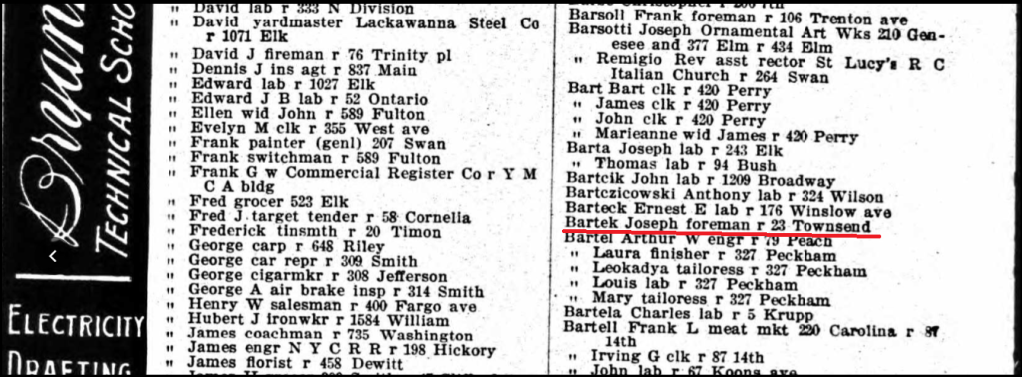
When I repeated my newspaper searches using this surname, at long last, I was able to locate articles about the fire at the Buffalo Cereal Company plant in 1910. And the Levanduski brothers? They were using the name Lendes! Figure 11 shows one of many newspaper headlines regarding the disaster.30
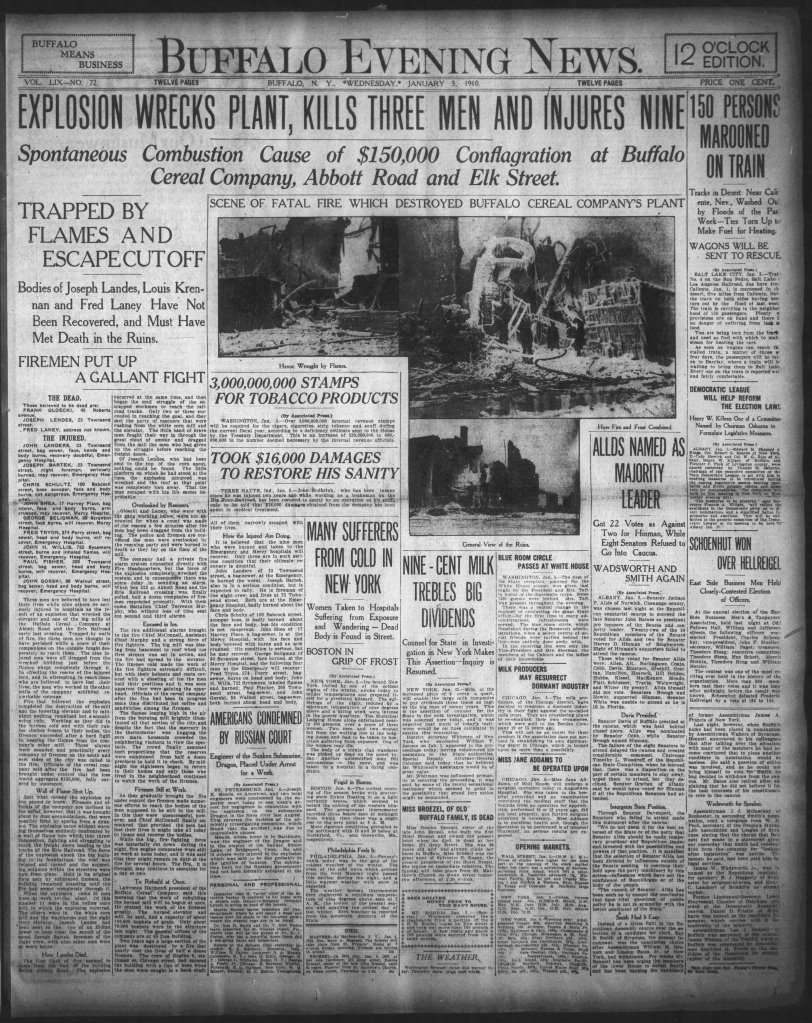
The Explosion
On the evening of 4 January 1910, with 30 men at work in the plant, the yellow corn mill of the Buffalo Cereal Company exploded into flames. The explosion was believed to have been caused by dust accumulations that were ignited by sparks from a dynamo. Eleven men were in the yellow corn mill where the explosion occurred, and the rest were in the white corn mill, the 8-story grain elevator, and the warehouse. The group of eleven men included Joseph Bartek, foreman of the night crew, and Joseph Lendes. Joseph Lendes had been sent to the top of an 85-foot tower to keep clear the mouth of the grain spout while his brother-in-law, Joseph Bartek, worked below with the other men.
The explosion completely destroyed the grain elevator and the yellow corn mill. Four men were reported to have died in the explosion and the resulting three-alarm fire, identified as Joseph Lendes, Frank Gloecki [sic], Fred Laney, and Louis Krennan. Of Joseph Lendes, the article states, “nothing could be found. The little platform on which he had stood at the time the explosion occurred was wrecked, and the roof was completely torn away. That the man escaped with his life seems improbable.” Nine more men were injured, including John Landers [sic] of 23 Townsend Street, Joseph Bartek, Chris Schultz, John Shea, George Seligman, Fred Tryon, John H. Willis, Paul Fisher, and John Gorski. John Landers was reported to be a bag sewer, who suffered “face, hands, and body burns” and was sent to Emergency Hospital, “recovery doubtful.” (The former Emergency Hospital is presently known as Sheehan Memorial Hospital.30) The article continued to report that of all the injured, John Landers was burned the worst. Joseph Bartek, the night foreman, was also sent to Emergency Hospital and was reported to be seriously burned, but “may recover.” The men who had been working in the other areas of the plant were reported to have fought their way through the smoke and flames to drag the injured men to safety.
The Buffalo Evening News published the story of the explosion at noon, 3 pm, and 5 pm on January 5. By the time the 5 pm edition was published, the story had been updated to include photos of some of the victims, including Joseph “Bartek” Bartoszewicz and John “Lendes” Levanduski (Figure 12). These were the only photos of Joseph Bartoszewicz and John Levanduski which my husband’s family had ever seen.
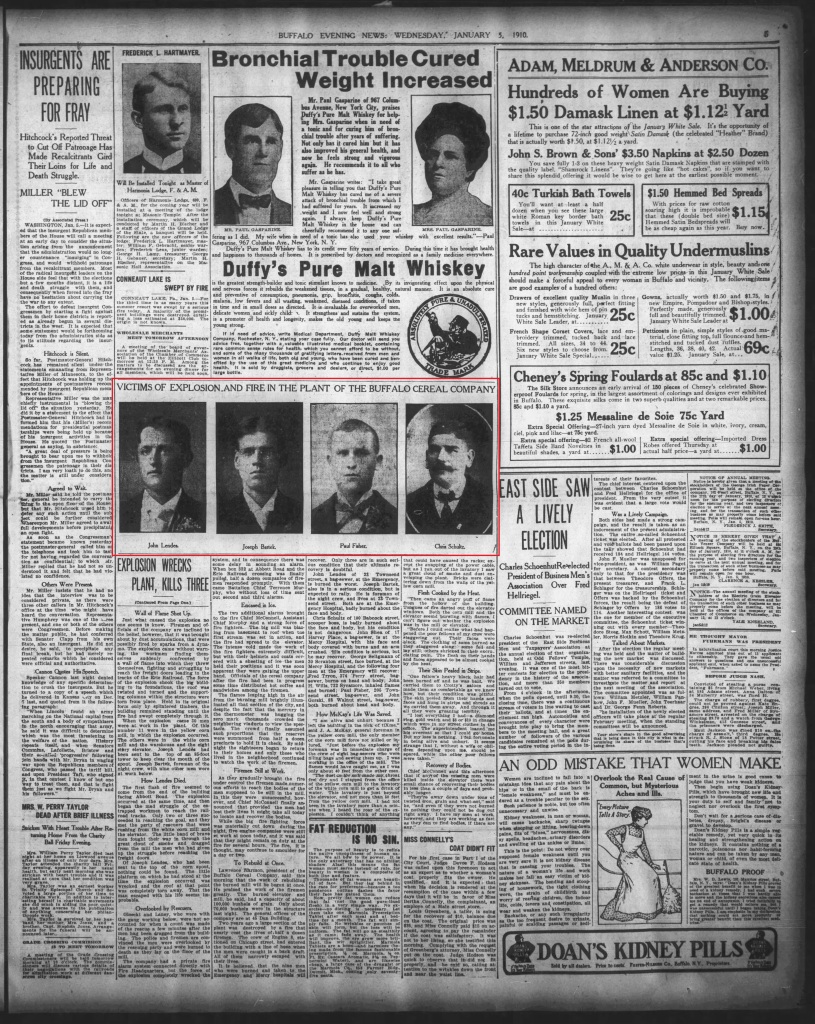
The Buffalo Courier reported on the same disaster, but in their article, John Landers was called John Lendes and Joseph Bartek was called Joseph Bortek.32 The Courier specified the relationship between John and Joseph, stating, “Joseph Landes, a brother of John, who is at Emergency Hospital, is another of the missing. John Landes said that his brother was working only a few feet away from him and he could not understand how they became separated even in the confusion following the explosion.” Interestingly, the Courier‘s report omits any mention of Frank Gloecki or Glodecki among the missing and presumed dead. The article further reported that some of the injured were initially taken to Crotty’s saloon at 82 Abbott Road, where the ambulances were summoned by Crotty, and, “When John Lendes was being carried to the ambulance from the saloon he became half crazed with pain and broke away from the attendants. He ran for half a block before he was captured by the doctors and then had to be overpowered before he could be taken to the hospital.”
The Aftermath
In the days and weeks that followed, the Levanduski family’s personal tragedy continued to unfold in the newspapers. On January 6, the Buffalo Commercial reported that Fred Laney, initially thought to have been killed in the explosion, was found alive, but that Joseph Lendes and Frank Glodecki remained unaccounted for. The frozen ruins were being searched for their bodies, but fire engines were “still pumping water on the smoldering mounds of grain.”33 According to the Commercial, Joseph Bartek and Chris Schultz were still in the Emergency Hospital but were recovering, while John Lendes and the others were still in serious condition. On January 10, the Buffalo Times reported that John Lendes died of his injuries.34 The article erroneously reports John’s age as 44, rather than 24, and similarly misstates Joseph’s age as 38, rather than 18. Despite this discrepancy, the article states that both of them lived “at the home of their sister, Mrs. Joseph Bartek, at No. 23 Townsend Street,” and continues, “Bartek, who was foreman at the elevator, was among those who received injuries at the fire and is now at the Emergency Hospital. Owing to his condition he was not informed this morning of the death of his brother-in-law in the same ward of the hospital in which he is lying.” John Levanduski was reported to be the fifth fatality from the explosion, with the other victims identified as Oscar Lawn [sic], Frank Gloeck, and Frank Zydell, and Joseph Lendes.


On January 15, the Buffalo Evening News reported that the body of Joseph “Lendes” Levanduski was recovered from the ruins (Figure 15).37 The article noted that Mrs. Joseph Bartek, sister of the deceased, “was called away from the bedside of her husband at the Emergency Hospital to identify the body of her brother.” By January 30, Joseph Bartek was still reported to be in the hospital, and the body of Oscar Lonn (or Lawn) was discovered.38 Incredibly, Frank Gloecki, who was initially identified as a victim of the explosion, was found to be alive, having never been at work on the night of the fire. As the article states, “Detective Jerry Condon of the Louisiana Street [Police] station, went to Gloecki’s home at No. 45 Roberts Street yesterday afternoon and found him leisurely sitting down, smoking a pipe and oblivious to all the harrowing tales that had been printed concerning his death.”

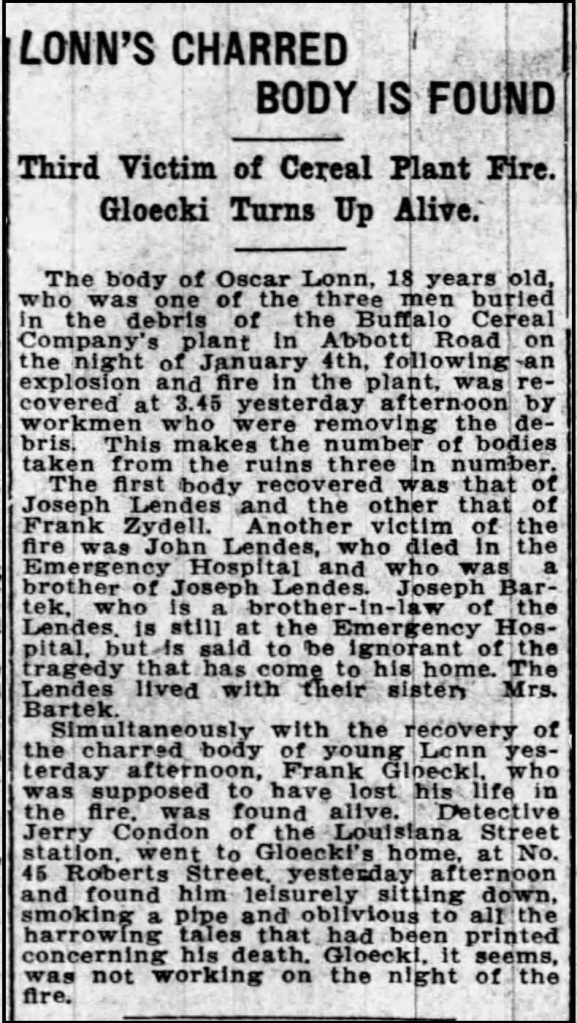
Eventually, Joseph Bartoszewicz was able to recover from that fire to the extent that he was able to return to full-time employment. However, the physical and psychological trauma of this fire left scars that remained with him until his dying day. His story remains to be told at another time.
Lendes, Lewandowski, and Levanduski, Revisited
Although all the details of the tragedy at the Buffalo Cereal Company plant on the night of 4 January 1910 lined up well with that kernel of truth in Grandma’s story, I nevertheless obtained copies the death certificates for both John and Joseph Lendes. Joseph’s death certificate is shown in Figure 17.39

The death certificate corrects the error reported in the newspaper that Joseph was 38 years old, and identifies him as the 19-year-old son of Stanislaus Lendes and Mary Wozniak, both born in Germany. (Joseph was only 18 in January 1910, but would turn 19 in May.) His date and place of birth, 16 May 1891 in Middleport, New York, agree with prior evidence. Joseph was buried in Holy Cross Cemetery, located in Lackawanna, New York, on 16 January 1910.
John’s death certificate is shows in Figure 18.40

Despite having been identified in the newspapers as John Lendes, John’s death certificate gave him back his original surname, John Lewandowski. His sister, Katherine Bartoszewicz of 23 Townsend Street was the informant, and she identified their parents as Stanislaus Lewandowski and Mary Wozniak. As with the death certificate for his brother, Joseph, the document corrects John’s age as it was erroneously reported in the newspaper, from 44 years to 24 years, 8 months, and 4 days. He was reported to have been born 6 May 1885 in Germany, consistent with prior evidence, and he was buried in St. Stanislaus Cemetery. His cause of death was “burns, accidental,” as a result of having been “caught in burning building.” Interestingly, John was reported to have been a resident of Buffalo for only one year, while Joseph had been a resident for four years. It may be that the information regarding Joseph’s residency is incorrect, since Katherine Bartoszewicz herself had likely only been a resident of Buffalo for the three years since her marriage in 1907.
John Levanduski’s death was also reported in the local Polish newspaper, the Polak w Ameryce (Figure 19).41
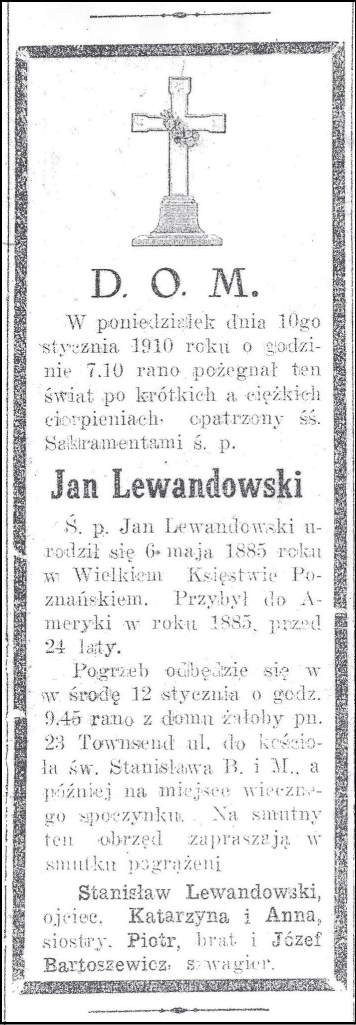
The death notice reads in translation,
“On Monday, the 10th day of January in the year 1910 at 7:10 in the morning, departed this world after short and heavy suffering, after having received the Sacraments, of holy memory,
Jan Lewandowski
The late Jan Lewandowski was born on 6 May 1885 in the Grand Duchy of Poznań. He came to America in 1885, 24 years ago.
The funeral will be held on Wednesday, 12 January, at 9:45 a.m. from the home of the bereaved at 23 Townsend St. to the church of St. Stanislaus, Bishop and Martyr, and afterwards to the place of eternal rest. To this sad rite the bereaved are invited.Stanisław Lewandowski, father, Katarzyna and Anna, sisters, Piotr, brother, and Józef Bartoszewicz, brother-in-law.”
The information on the death notice agrees with all the previous evidence for John Levanduski’s place and date of birth, arrival in the U.S., and the names of his surviving father and full siblings. The death notice was obtained courtesy of the Polish Genealogical Society of New York State, following a search of their databases. The PGSNYS also offers this guide for translation of these death notices.
Every family has its share of loss, sorrow, and tragedy, and the Levanduski family was certainly no exception. Unfortunately, the family stories that draw us into genealogical research don’t always have happy endings, but the tragic stories are no less worthy of being told. Although John and Joseph Levanduski left no descendants to remember them and to say their names, their story was preserved in the paper trail of newspapers and documents. With a little persistence, that story has come to light. Rest in peace, John and Joseph Levanduski.
© Julie Roberts Szczepankiewicz 2022
Sources:
1 “Najpopularniejsze nazwiska w Polsce” [Most popular surnames in Poland], Internet Archive, Wayback Machine (https://web.archive.org/web/20080518171439/http://www.futrega.org/etc/nazwiska.html : 04 March 2022), citing site capture from 18 May 2008, citing original data from the Słownik Nazwisk współcześnie w Polsce używanych [Dictionary of Polish Surnames in Modern Usage] found at http://herby.com.pl/.
2 “Urząd Stanu Cywilnego Rogowo-Wieś, 1874-1913,” (Rogowo, Żnin, Kujawsko-Pomorskie, Poland), Akta małżeństw, 1882, no. 38, Stanislaus Lewandowski and Marianna Wozniak, 9 September 1882; digital image, Genealogiawarchiwach (https://www.genealogiawarchiwach.pl/ : 04 March 2022), images 39 and 40 of 68, citing Archiwum Państwowe w Bydgoszczy Oddział w Inowrocławiu, Sygnatura 7/540/0/2.2/26.
3 “Wola 1)” [Wola, Znin, Bromberg, Posen, Preussen], Search the Meyers Gazetteer (https://www.meyersgaz.org/ : 04 March 2022), citing Uetrecht, E. (Erich), Meyers Orts- und Verkehrs-Lexikon des Deutschen Reichs, 5th edition, Leipzig and Wien: Bibliographisches Institut, 1912, p 1180.
4 “Urząd Stanu Cywilnego Rogowo-Wieś, 1874-1913,” Akta urodzeń, 1883, no. 208, Catharina Lewandowska, 11 October 1883; digital image, Genealogiawarchiwach (https://www.genealogiawarchiwach.pl : 04 March 2022), image 209 of 268, citing Archiwum Państwowe w Bydgoszczy Oddział w Inowrocławiu, Sygnatura 7/540/0/2.1/28; and
“Urząd Stanu Cywilnego Rogowo-Wieś, 1874-1913,” 1885, Akta urodzeń, no. 93, Johann Lewandowski, 5 May 1885; digital images, Genealogiawarchiwach (https://www.genealogiawarchiwach.pl : 04 March 2022), image 93 of 262, citing Archiwum Państwowe w Bydgoszczy Oddział w Inowrocławiu, Sygnatura 7/540/0/2.1/34.
5 Manifest, SS Sprite, departing Hamburg, Deutschland, 10 April 1886, p. 559, lines 11-15, Lewandowsky family and Weronika Wozniak; imaged as “Hamburg Passenger Lists, 1850-1934,” database with images, Ancestry (https://ancestry.com/ : 04 March 2022); citing Staatsarchiv Hamburg, Bestand: 373-7 I, VIII (Auswanderungsamt I). Mikrofilmrollen K 1701 – K 2008, S 17363 – S 17383, 13116 – 13183.
6 Roman Catholic Church, St. Stephen’s parish (Middleport, Niagara, New York, USA), “Church Records, 1878-1917,” Baptisms, 1878-1901, unnumbered entries in chronological order, 10 June, Patricius Levendeski, born 28 May 1888; digital image, FamilySearch (https://www.familysearch.org : 3 March 2022), FHL film no. 1378522, item 1/DGS no. 8273181, image 19 of 154.
7 Joseph J. Levanduski, Jr., Medina, New York, email to Julie Szczepankiewicz, 14 March 2007; Correspondence with Joseph Levanduski, privately held by Julie Szczepankiewicz.
8 Roman Catholic Church, St. Stephen’s parish (Middleport, Niagara, New York, USA), “Church Records, 1878-1917,” Baptisms, 1878-1901, 1891, unnumbered entries in chronological order, 17 February, Josephum Levendeski, born 15 February 1891; digital image, FamilySearch (https://www.familysearch.org: 05 March 2022), FHL film no. 1378522, item 1/DGS no. 8273181, image 23 of 154.
9 Roman Catholic Church, St. Stephen’s parish (Middleport, Niagara, New York, USA), “Church Records, 1878-1917,” Marriages, 1878–1900, unnumbered entries in chronological order, 1889, June 22, Eduardus Lipkoski and Veronica Wisnaik; digital image, FamilySearch (https://www.familysearch.org : 6 March 2022), Family History Library film no. 1378522, item 4/DGS no. 8273181, image 128 of 154.
10 New York, Supreme Court, Orleans County, Petitions for Naturalization, 1887-1893, vol. 5, p. 291, Stanislaw Lewandowski, 14 September 1891; digital image, FamilySearch (https://www.familysearch.org : 06 March 2022); image 169 of 278.
11 New York, State Census, 1892, Orleans County population schedule, Shelby, Election District no. 3, page 15, Adcker Lewenoboski household; digital image, Ancestry (https://search.ancestry.com : 6 March 2022), citing New York State Education Department, Office of Cultural Education. New York State Library, Albany, NY.
12 Roman Catholic Church, St. Stephen’s parish (Middleport, Niagara, New York, USA), Church Records, 1878-1917, unnumbered entries in chronological order, 1893, 1 January, Veronica Levenduski, born 26 December 1892; digital image, FamilySearch (https://www.familysearch.org : 7 March 2022), Family History Library film no. 1378522 item 1/DGS no. 8273181, image 26 of 154.
13 Death records from St. Stephen’s in Middleport are available from the date of Veronica’s birth through March 1899, and there is no death record for her. There is also no good match in the “New York, U.S., Death Index, 1852-1956,” searching for “?e??nd?sk*” in 1896 +/- 5 years.
14 Roman Catholic Church, St. Stephen’s parish (Middleport, Niagara, New York, USA), Church Records, 1878-1917, Baptisms, 1878-1901, unnumbered entries in chronological order, 1894, 24 June, Anna Levendeski, born 14 June 1894; digital image, FamilySearch (https://www.familysearch.org : 7 March 2022), Family History Library film no. 1378522, item 1/DGS no. 8273181, image 27 of 154.
15 Town Clerk, Shelby, Orleans, New York, Death Register, unknown range of dates, no. 72, Mary Levenduski, 10 April 1896; Shelby Town Hall, 4062 Salt Works Rd., Medina, New York.
16 Roman Catholic Church, St. Stephen’s parish (Middleport, Niagara, New York, USA), Church Records, 1878-1917, Record of Marriages, 1878–1900, unnumbered entries in chronological order, Levendeski et Budzinski, 12 May 1896; digital image, FamilySearch (https://www.familysearch.org/ : 7 March 2022), Family History Library film no. 1378522, item 1/DGS no. 8273181, image 132 of 154.
17 Roman Catholic Church (Niestronno, Mogilno, Kujawsko-Pomorskie, Poland), “Ksiegi metrykalne, 1722-1952,” Akta urodzen 1866-1913, 1867, no. 1, Antonina Budzinska, born 5 January 1867; digital images, FamilySearch (https://www.familysearch.org/ : 7 March 2022), Family History Library Film no .2151453 item 5/DGS no. 8120936, image 873 of 1037.
18 Roman Catholic Church, St. Stephen’s parish (Middleport, Niagara, New York, USA), Church Records, 1878-1917, Baptisms, 1878-1901, 1897, unnumbered entries in chronological order, 28 February, Antonius Levendeski, born 23 February 1897; digital image, FamilySearch (https://www.familysearch.org: 07 March 2022), FHL film no. 1378522, item 1/DGS no. 8273181, image 30 of 154; and
Ibid., 1898, 14 August, Ladislaus Lavenduski, born 8 August 1898; image 33 of 154; and
Ibid., 1899, July 23, Martha Levinduski, born 14 July 1899; image 63 of 154.
19 1900 United States Federal Census, Orleans County population schedule, Shelby township, Enumeration District 110, sheets 21A and B, family no. 543, Edward Lavendusky household; digital image, Ancestry (https://www.ancestry.com/ : 9 March 2022), citing NARA publication T623, 1,854 rolls, no particular roll specified.
20 1905 New York State census, Orleans County population schedule, town of Shelby, Election District 2, page 43, lines 3-13, Edward Levenduski household; database with images, Ancestry (https://www.ancestry.com : 9 March 2022), “New York, U.S., State Censuses, 1880, 1892, 1905” > 1905 > Orleans > Shelby > image74 of 80.
21“New York, U.S., Death Index, 1852-1956,” database with images, Ancestry (https://search.ancestry.com/ : 9 March 2022), Martha Levenduski, 13 August 1900, Shelby, New York, certificate no. 32891.
22 Roman Catholic Church, St. Stephen’s parish (Middleport, Niagara, New York, USA), Baptizorum Registrum, 1899-1943, p 15, unnumbered entries in chronological order, Josepha Levinduski, born 17 February 1903; digital image, FamilySearch (https://www.familysearch.org : 10 March 2022), “Church Records, 1878-1917,” FHL film no. 1378522, item 1/DGS no. 8273181, image 70 of 154; and
Ibid., Mariannam Levinduski, born 30 January 1901; image 67 of 154.
23 Roman Catholic Church, St. Stephen’s parish (Middleport, Niagara, New York), “Record of Marriages, 1900 – ?”, p 18, 1907, unnumbered entries in chronological order, 29 April, Bartoszewicz & Levinduski; Holy Trinity Parish (Parish created by merger of St. Stephen’s in Middleport with Sacred Heart and St. Mary’s parishes in Medina), 211 Eagle Street, Medina, New York.
24 Manifest, SS Pennsylvania, arrived 13 October 1890, p 3, lines 19-29, Bartuszewitz family; imaged as “Pennsylvania, U.S., Arriving Passenger and Crew Lists, 1800-1962.” database with images, Ancestry (http://search.ancestry.com : 12 March 2022), citing National Archives at Washington, D.C., “Passenger Lists of Vessels Arriving at Philadelphia, Pennsylvania,” Record Group No. 85, series T840, roll no. 14, image 345 of 860.
25 Supreme Court of Erie County, New York, Petition for Naturalization no. 2653, Joseph Bartoszewicz, 9 February 1914; Erie County Clerk, 92 Franklin St., Buffalo, NY 14202.
26 Buffalo Street Directory 1909, no author or original publication data available, p 168, entry for Bartosiewicz, Joseph, accessed as browsable images, Ancestry (https://www.ancestry.com/ : 12 March 2022), path: “U.S. City Directories, 1822-1995,” > New York > Erie > Buffalo > 1909 > Buffalo, New York, City Directory, 1909 > image 82 of 482; and
Hausauer-Jones Printing Company, A History of the City of Buffalo: Its Men and Institutions: Biiographical Sketches of Leading Citizens, (Buffalo, New York: The Buffalo Evening News, 1908), pp 123-124, “The Buffalo Cereal Company;” e-book, Internet Archive (https://archive.org/ : 12 March 2022).
27 Ibid.
28 “Reducing the Risk of Explosion in Flour Mills,” Hafcovac (https://www.hafcovac.com/blog/ : posted 16 January 2020, accessed 12 March 2022).
29 Buffalo Street Directory 1909, no author or original publication data available, p 167, entry for Bartek, Joseph, and p 168, entry for Bartosiewicz, Joseph, accessed as browsable images, Ancestry (https://www.ancestraccessed as browsable images, Ancestry (https://www.ancestry.com/ : 15 May 2020), path: “U.S. City Directories, 1822-1995,” > New York > Erie > Buffalo > 1909 > Buffalo, New York, City Directory, 1909 > images 81 and 82 of 482.
30 “Explosion Wrecks Plant, Kills Three Men and Injures Nine: Spontaneous Combustion Cause of $150,000 Conflagration at Buffalo Cereal Company, Abbott Road and Elk Street.,” Buffalo Evening News (Buffalo, New York), 05 January 1910 (Wednesday), 12 pm edition, p. 1, cols. 1–3; 3 pm edition, p. 1; 5:00 pm edition, pp. 1 and 5; digital images, Newspapers (https://www.newspapers.com/image/351516885/ : 14 March 2022).
31 “Sisters of Charity Hospital (Buffalo, N.Y.),” Social Networks and Archival Context (https://snaccooperative.org/ : 14 March 2022).
32 “Explosion Wrecks Big Plant; Nine Seriously Hurt, Three Are Missing,” Buffalo Courier (Buffalo, New York) 5 January 1910, p 1, cols 5-6, page 7, cols. 2-3; digital image, Newspapers (https://www.newspapers.com : 14 March 2022). https://www.newspapers.com/image/370538152.
33 “Laney is Alive: Was Thought to Have Been Killed in Cereal Company Explosion. Two Still Missing. Frozen Ruins Are Being Searched for Bodies of Lendes and Glodecki,” The Buffalo Commercial (Buffalo, New York), 6 June 1910 (Thursday), p. 10, col. 3; digital image, Newspapers (https://www.newspapers.com :14 March 2022).
34 “Dies While His Brother’s Body Lies in Debris: John Lendes, A Victim of Buffalo Cereal Company’s Fire. Bodies of Joseph Lendes and Three Other Men Still in the Ruins,” The Buffalo Times (Buffalo, New York), 10 January 1910 (Monday), p 4, col. 3; digital image, Newspapers (https://www.newspapers.com : 14 March 2022).
35 “Sixth Victim of Cereal Company Fire,” Buffalo Evening News (Buffalo, New York) 11 January 1910 (Tuesday), p 11, col. 6; digital image, Newspapers (https://www.newspapers.com : 15 March 2022), image 27 of 32.
36 “May Be Third Death in Same Family,” Buffalo Evening News (Buffalo, New York), 13 January 1910 (Thursday), p. 11, col. 2; digital image, Newspapers (https://www.newspapers.com : 15 March 2022), image 27 of 32.
37 “Joseph Lendes’ Body Found in the Ruins: First of Four Victims of the Buffalo Cereal Company Fire to Be Recovered,” Buffalo Evening News (Buffalo, New York), 15 January 1910 (Saturday), p. 1, col. 2; digital image, Newspapers (https://www.newspapers.com : 15 March 2022), image 1 of 24.
38 “Lonn’s Charred Body Is Found: Third Victim of Cereal Plant Fire. Gloecki Turns Up Alive,” The Buffalo Times (Buffalo, New York), 30 January 1910 (Sunday); digital image, Newspapers (https://www.newspapers.com : 15 March 2022), image 29 of 63.
39 City of Buffalo, Bureau of Vital Statistics (Buffalo, Erie, New York), “Death Certificates,” 1910, no. 95, Joseph Lendes, 14 January 1910, Erie County Clerk’s Office, 92 Franklin St., Buffalo, New York.
40 Ibid., no. 422, John Lewandowski, 10 January 1910.
41Polak w Ameryce (Buffalo, New York), 11 January 1910, death notice for Jan Lewandowski, Polish Genealogical Society of New York State, Buffalo, New York.



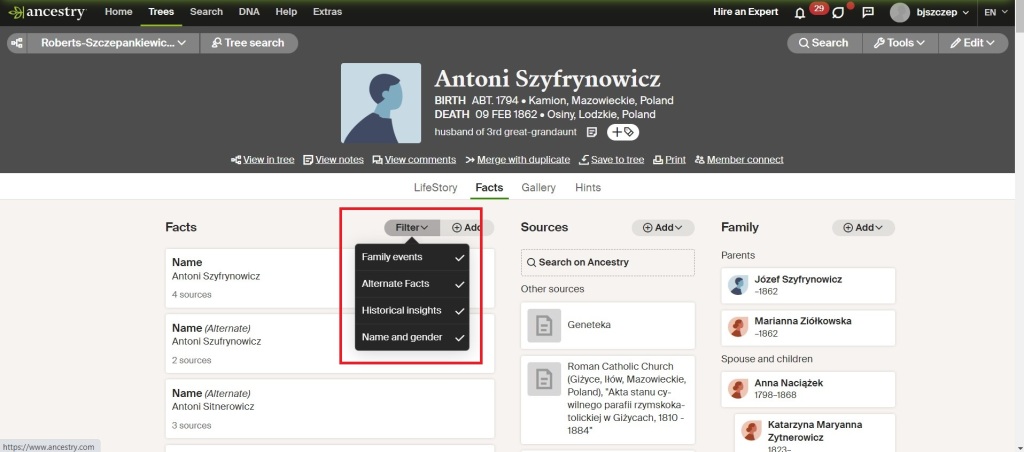



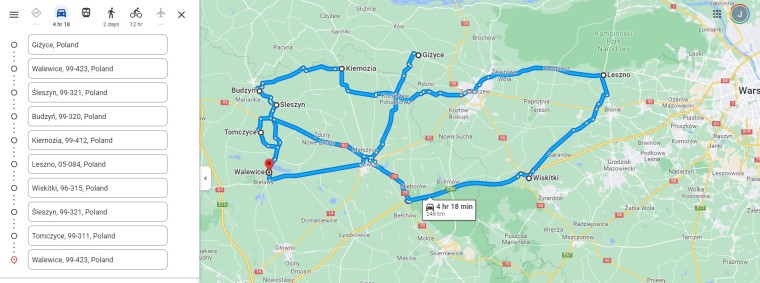




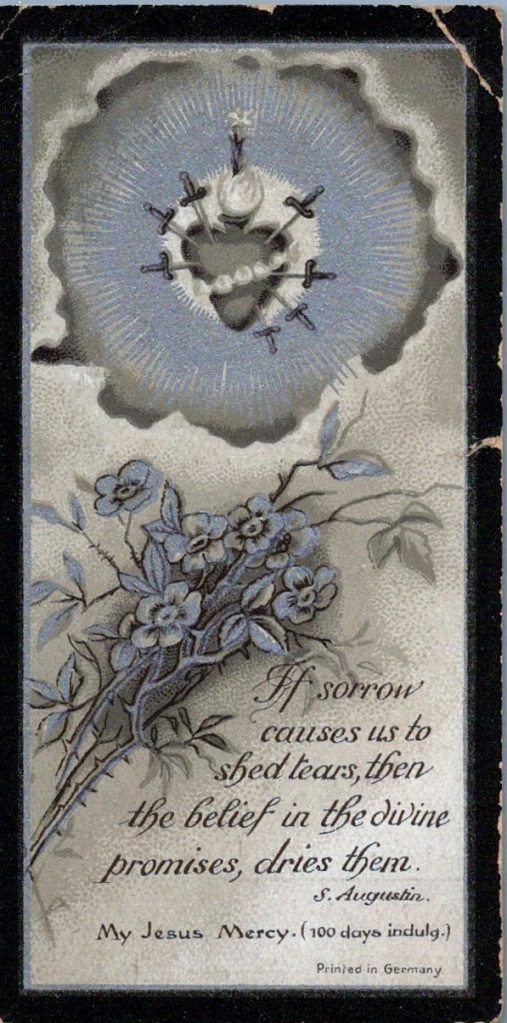















![Mappa jeneralna Województwa Mazowieckiego ułożona według naylepszych zrodeł przez Juliusza Colberg [General map of the Mazowiecki Voivodeship arranged according to the best sources by Juliusz Colberg], 1826.](https://fromshepherdsandshoemakers.files.wordpress.com/2022/05/48604650.jpg?w=940)












